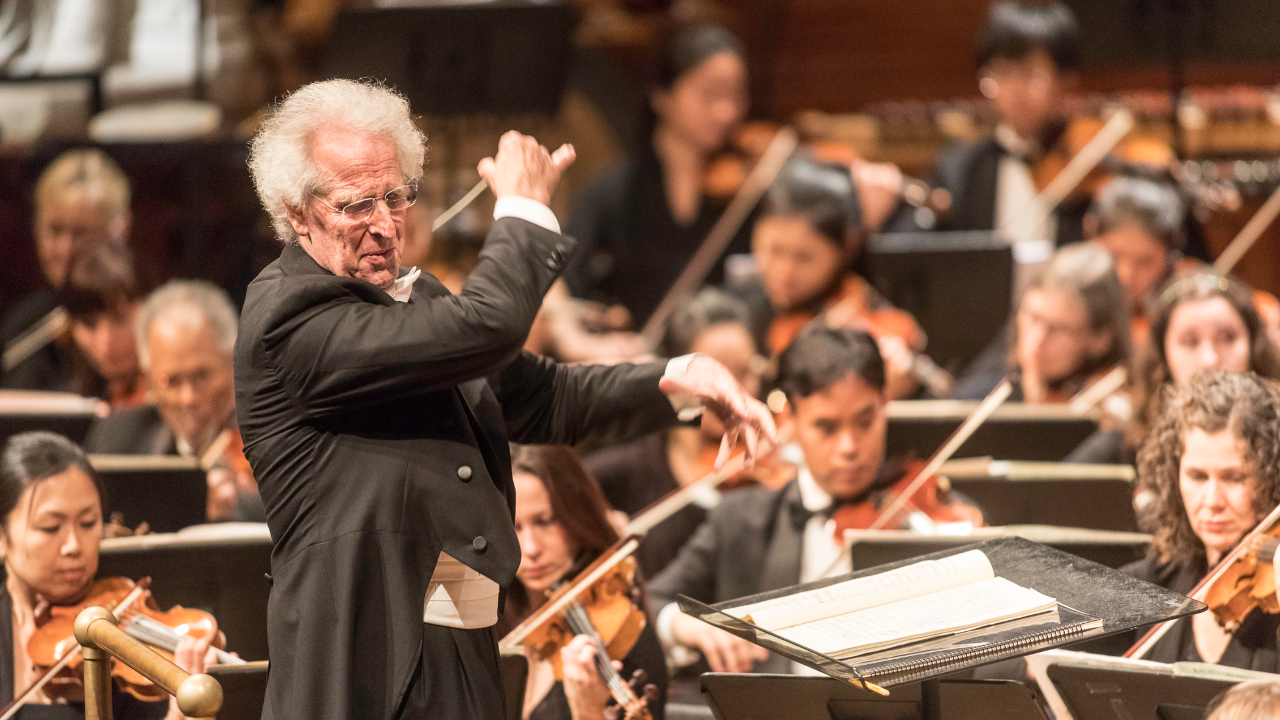Zander, Jackiw and Boston Philharmonic imbue familiar works with fresh purpose

Familiarity, the saying goes, breeds contempt. But, especially in music, this adage is sometimes turned on its head: after all, the well-known can also beget wonder and revelation.
So it did Wednesday night in the Boston Philharmonic Orchestra’s second program of the season at Symphony Hall. The evening’s program, led by Benjamin Zander was canonic: Felix Mendelssohn’s Hebrides Overture, Sergei Prokofiev’s Violin Concerto No. 2, and Johannes Brahms’ Symphony No. 4.
Yet the orchestra’s playing was anything but commonplace. Rather, this was a performance of favorites marked by uncommon vigor and purpose.
Mendelssohn’s 1830 depiction of his sea voyage to Fingal’s Cave, off the coast of Scotland, was beautifully shaped and blended. Its lyrical episodes, especially Rane Moore’s radiant clarinet solos, soared. At the same time, the Overture’s rhythmic profile was taut, its raging climaxes elemental.
In Prokofiev’s hyper-virtuosic 1935 score, the BPO was joined by violinist Stefan Jackiw. Making his fourth appearance with the Philharmonic, Jackiw is a violinist of astounding technical brilliance. The notes are all audibly there, regardless of the briskness of tempo or the knottiness of texture.
But he’s also an interpreter of exceptional nuance. His playing can be meltingly sweet one moment, steely the next. He doesn’t hide behind his vibrato; actually, Jackiw will sometimes eschew it for whole stretches. What’s more, his playing encompasses a range of characters: playful, sensuous, brawny, dancing, and much in between.
On Wednesday, Jackiw’s account of the Prokofiev’s solo line demonstrated all of this and more. He shaped the first movement’s lyrical episodes in beguiling fashion and imbued the passagework with playful esprit. Likewise, he spun out the central movement’s gorgeous refrain unaffectedly, while articulating its second subject with rubato and color. The finale snapped and slashed in a brilliant display of violinistic prowess.
For their part, the BPO was flawlessly balanced with Jackiw. Throughout the performance, the orchestra’s attention to dynamics was exquisite. Yet their playing never sounded scrawny. On the contrary: there was often a chamber-like quality to the ensemble’s exchanges with the soloist, particularly over the first two movements.
Zander ensured that the music’s tempos all moved purposefully. He also drew out a host of details in the scoring. Accordingly, Wednesday’s interpretation of this piece was highly organic, one in which the subtleties of its orchestral melodic writing always came through.
Indeed, taken together with Jackiw’s solos, the larger reading was epiphanic: tonally pure, precise of pitch and vitality, this was a Prokofiev Second of rare clarity, warmth, and soul.
Jackiw’s encore—the Largo from Bach’s Violin Sonata in C major—was more of the same: rapt, inward-focused and with an improvisatory feel.
Like the Prokofiev, the Brahms Fourth Symphony that ended the night was wholly compelling.
This 1885 score, the composer’s last in the genre, has long been a Zander favorite: Wednesday’s was, by the conductor’s count, his seventh local performance of the work.
His enthusiasm for making clear the music’s textural densities and expressive ambiguities was evident from the first movement’s downbeat: everything flowed. While Zander’s phrasings were flexible, the BPO’s playing was rhythmically tight and richly burnished. The opening theme, always bittersweet and dancing, ceded way to playing of nebulous mystery in the development and a roaring, passionate exegesis of the coda.
The second, with its majestic hymn-like figures, vigorous fugato, and surging apotheosis was beautifully shaped, the dovetailing figures in the central part all smoothly connected. Similarly engaging was the third movement, whose rough-and-tumble aspect was underlined by biting brass-and-timpani accents.
In the turbulent finale, Zander’s brisk tempos, seamless transitions between the variations, and bold shadings of the melodic line translated into a fascinating study in musical tension and release. Solace came via the refulgent, mid-movement woodwind solos and noble horn and trombone chorales. Meanwhile, the movement’s stormy outer thirds raged, culminating in a rendering of the closing bars that was furious and defiant.
This was a Brahms Fourth of heroic, tragic proportions. Fittingly, it was received with thunderous applause.
Click here to listen to Brahms’ Fourth Symphony.
Click here to listen to a Concert Talk on Brahms’ Fourth Symphony.
 Jonathan Blumhofer - Boston Classical Review
Jonathan Blumhofer - Boston Classical Review